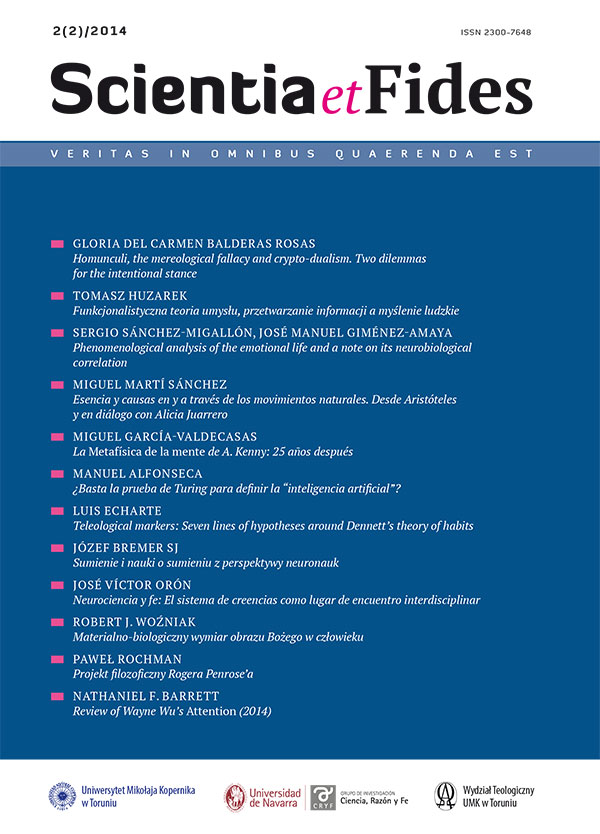Sumienie i nauki o sumieniu z perspektywy neuronauk
DOI:
https://doi.org/10.12775/SetF.2014.020Keywords
conscience, moral judgements, neuroimaging, neurosciences, emotions, deontology, consequentialismAbstract
Neuroscientific perspectives on conscience and conscience-related research
Recent years have witnessed a growth in empirical research into the biological correlates of conscience and moral decision-making. The central questions posed and addressed in such neuroscientific investigations concern (a) the role of the emotions in decisions of conscience, and (b) the determining of the particular brain regions that correlate with these decisions. Responding to these, I shall first outline the basic terminology involved and present the neuroethical analyses of Churchland, together with the findings of the empirical studies carried out by Greene, Damasio and others. I then offer a critical assessment of Greene’s thesis claiming that deontology should be denied the status of a moral theory, before addressing the issue of whether it is at all possible to arrive at conclusions about the correctness of any sort of moral theory – be it deontological or consequentialist – on the basis of empirical research.
References
Biesaga, T. 2004. „Konsekwencjonalizm.” W Powszechna encyklopedia filozoficzna. Lublin: KUL, Polskie Towarzystwo Tomasza z Akwinu, t. 5: 801-803.
Blackburna, S. 1993. How To Be an Ethical Anti-Realist. Essays in Quasi-Realism. New York: Oxford University Press.
Bremer, J. 2013. „Czym jest neuromarketing?” Communication Today 1/4: 18-34.
Bremer, J. 2013. Czy wolna wola jest wolna? Kompatybilizm na tle badań interdyscyplinarnych. Kraków: WAM.
Bremer, J. 2005. Jak to jest być świadomym. Analityczne teorie umysłu a problem świadomości. Warszawa: IFiS PAN.
Bremer, J. 2010. Wprowadzenie do filozofii umysłu. Kraków: WAM.
Brians, P. 2013. Common Errors in English Usage, Portland/OR: William, James & Company.
Churchland, P. 2013. Moralność mózgu. Co neuronauka mówi o moralności. Kraków: Copernicus Center Press. Przekład: M. Hohol. [oryg.: 2011. Braintrust: What Neuroscience Tells Us about Morality. Princeton: Princeton UP.].
Damasio, A.R. 2011. Błąd Kartezjusza. Emocje, rozum i ludzki mózg. Poznań: Rebis. Przekład: M. Karpiński.
Dennetta, D. 1993. La conscience expliquée. Paris: Odile Jacob.
Dewey, J. 1906. ”The Terms 'Conscious' and 'Consciousness'.” Journal of Philosophy, Psychology and Scientific Method 3: 39-41. DOI: http://dx.doi.org/10.2307/2011714.
Duch, W. 2008/2009. „Emocje i układ limbiczny.” http://www.fizyka.umk.pl/~duch/Wyklady/Mozg/07-3-limbiczny.htm, dostęp: 26.07.14.
Duus, P. 1989. Diagnostyka topograficzna w neurologii. Warszawa: Państwowy Zakład Wydawnictw Lekarskich.
Greene, J. 2007. “The Secret Joke of Kant’s Soul.” W W. Sinnott-Armstrong (red.), Moral Psychology, t. 3: The Neuroscience of Morality: Emotion, Brain Disorders, and Development, Cambridge/MA, and London: MIT Press, 35-79.
Hallgarth, M.W. 1996. „Consequentialism and Deontology.” W R. Chadwicks (red.), Encyclopedia of Applied Ethics. San Diego: Academic Press, t. 1: 609-621.
Hanson, J.L., Chung, M.K., Avants, B.B., Shirtcliff, E.A., Gee, J.C., Davidson, R.J., Pollak, S.D. 2010. “Early Stress Is Associated with Alterations in the Orbitofrontal Cortex: A Tensor-Based Morphometry Investigation of Brain Structure and Behavioral Risk.” The Journal of Neuroscience 22/30.
Hoffman, M.B. 2014. The Punisher’s Brain. N. York: Cambridge University Press.
Hume, D. 1963. Traktat o naturze ludzkiej. Warszawa: PWN. Przekład: Cz. Znamierowski.
Kant, I. 1984. Krytyka praktycznego rozumu. Warszawa: PWN. Przekład: J. Gałecki.
Kant, I. 2005. Metafizyka moralności. Warszawa: WN PWN. Przekład: E. Nowak.
Koenigs, M., Young, L., Adolphs, R., Tranel, D., Cushman, F., Hauser, M., Damasio, A. 2007. “Damage to the Prefrontal Cortex Increases Utilitarian Moral Judgments.” Nature 446: 908-911.
Kranich-Strötz, Ch. 2008. Selbstbewusstsein und Gewissen: Zur Rekonstruktion der Individualitätskonzeption bei Peter Abaelard - Subjekt, Zeit, Geschichte. Berlin: LIT-Verlag, t. 2.
Kringelbach, M.L., Rolls, E.T. 2004. “The Functional Neuroanatomy of the Human Orbitofrontal Cortex: Evidence from Neuroimaging and Neuropsychology.” Progress in Neurobiology 72: 341–372.
Neubertemail, F.-X., Mars, R.B., Thomas, A.G., Sallet, J., Rushworth, M.F.S. 2014. “Comparison of Human Ventral Frontal Cortex Areas for Cognitive Control and Language with Areas in Monkey Frontal Cortex.” Neuron 3/81: 700–713.
Nunner-Winkler, G. 2006. “Freiwillige Selbstbindung aus Einsicht - ein moderner Modus moralischer Motivation.” W H.F. Klemme, M. Kühn, D. Schönecker (red.), Moralische Motivation: Kant und die Alternativen. Hamburg: Felix Meiner, 165-192.
Raab, G., Gernsheimer, O., Schindler, M. 2009. Neuromarketing: Grundlagen – Erkenntnisse – Anwendungen. Wiesbaden: Gabler Verlager.
Singer, T., Seymour, B., O’Doherty, J., Kaube, H., Dolan, R.J., Frith, Ch.D. 2004. “Empathy for Pain Involves the Affective but not Sensory Components of Pain.” Science 303: 1157-1162. DOI: http://dx.doi.org/10.1126/science.1093535.
Stach, R., Popek, A.M. 2013. „Decyzje ekonomiczne i społeczne z perspektywy pogranicza neuronauk oraz nauk o zarządzaniu.” International Journal of Contemporary Management 2/13: 48–57.
Tomasz z Akwinu. 1952. Summa Theologiae. Romae: Marietti.
Urbańczyk, S. (red.). 1977-1981. Słownik staropolski. Wrocław: Ossolineum, t. 8: 505-506.
Wayne, M. 2006. Conscience and Consciousness: Rousseau's Critique of the Stoic Theory of Oikeosis. http://philosophy.fas.nyu.edu/object/philo.courses.ml06.html, dostęp: 24.05.14.
Downloads
Published
How to Cite
Issue
Section
License
Copyright (c) 2014 Scientia et Fides

This work is licensed under a Creative Commons Attribution-NoDerivatives 4.0 International License.
CC BY ND 4.0. The Creator/Contributor is the Licensor, who grants the Licensee a non-exclusive license to use the Work on the fields indicated in the License Agreement.
- The Licensor grants the Licensee a non-exclusive license to use the Work/related rights item specified in § 1 within the following fields: a) recording of Work/related rights item; b) reproduction (multiplication) of Work/related rights item in print and digital technology (e-book, audiobook); c) placing the copies of the multiplied Work/related rights item on the market; d) entering the Work/related rights item to computer memory; e) distribution of the work in electronic version in the open access form on the basis of Creative Commons license (CC BY-ND 3.0) via the digital platform of the Nicolaus Copernicus University Press and file repository of the Nicolaus Copernicus University.
- Usage of the recorded Work by the Licensee within the above fields is not restricted by time, numbers or territory.
- The Licensor grants the license for the Work/related rights item to the Licensee free of charge and for an unspecified period of time.
FULL TEXT License Agreement
Stats
Number of views and downloads: 739
Number of citations: 0



